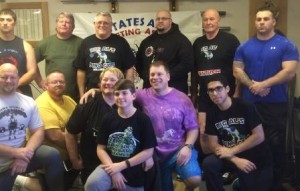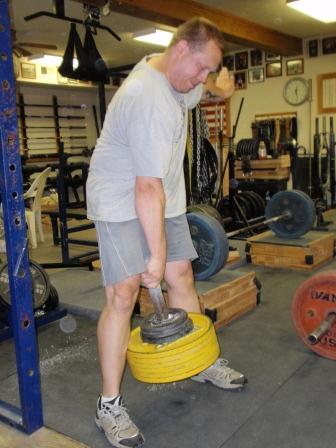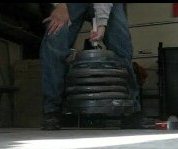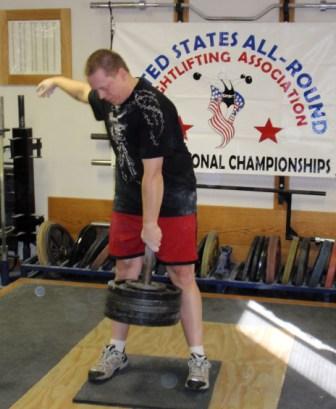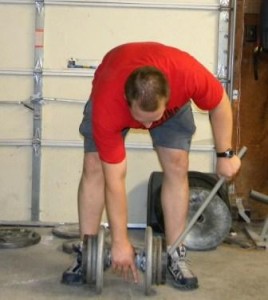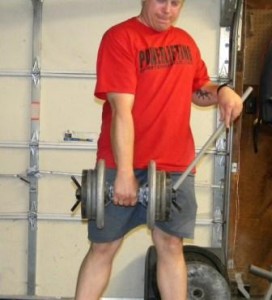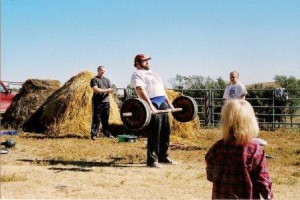by Ben Edwards
The 2010 Dino Grip Challenge started on time, as Al mentioned already, and it ended 3 hours later – which is an unofficial record as far as I know for grip contests. Most that I have competed in have been anywhere from 5 hours to nearly 8! A shorter contest is much more competitor-friendly and allows more time to do after-contest feats and record attempts. And more time to drive back to wherever the competitors call home.
Before listing who the competitors were, I want to mention the competitors who had planned on competing, but couldn’t make it for various reasons. Kevin Fulton, Mary McConnaughey, Nick Zinna, and Josh Dale. You were all sorely missed!
I’m going to list some thoughts and observations on each competitor, starting with 1st place and working my way to 8th place. The placings were age-adjusted and also used the Lynch formula, as is standard in USAWA competitions. I like the age adjustment and use of the Lynch formula in competitions because it lets many different ages and weights compete against each other on what I believe is fair footing.
1st Place: Andrew Durniat is fast becoming a legend in the grip strength world. His accomplishments are too numerous for this meet report. Simply put, he is the 2009 Grip Champion and the US Kettlebell Champion.
He stayed the night before the contest with me and my wife, Carrie. I really enjoyed getting to chat with him and pick his brain on everything that I had planned on asking him – and a few other things that popped into my head as we spoke. He’s very friendly, has a quiet demeanor, is extremely humble and generous with his time and help, and he pays close attention to the relevant details of anything relating to strength.
I expected a mindblowing performance from Andrew and was definitely not disappointed! He won every event except for the Deadlift – Fingers, Little. He went on to pull 25lbs over my event-winning performance on an extra record attempt! His loss in that event was only due to inexperience with choosing his attempts on a lift that he had never even attempted before the contest.
With all due respect to my fellow competitors, it quickly became apparent to me that this contest was really a case of who was going to be 2nd after Andrew! He won $100 cash for his 1st place finish!
Andrew did so many record-breaking lifts that it’s hard to pick the one that most impressed me. One that really strikes me as unbelievably strong is his 308lb Deadlift – No Thumb, One Arm! That lift was 33lbs over the previous all-time record that Al Myers and I co-owned. Andrew also pulled it to full lockout – in front of his body, which I always found to be harder than straddle style – and then paused it with plenty of strength to spare. Phenomenal lift!
Andrew is an incredible addition to the USAWA membership pool. He brings a passion for strength sports and a vast in-the-trenches knowledge of many training methodologies from his personal training experience. He also generously gave out some of his great personalized shirts after the meet. I love collecting shirts from contests and from strength friends, so thanks Andrew!
2nd Place: Larry Traub was an unknown to me. He turned out to be a “sleeper” in this competition. Someone who most competitors probably wouldn’t have predicted would get 2nd place since it was his first grip contest. It definitely wasn’t Larry’s first strength competition though! He is an elite powerlifter with terrific deadlifting strength. Larry put that hard-earned horsepower to work and plowed through some heavy lifts. Along the way he set many age-group and weight class records. Larry is in very good shape and Al can attest to the fact that I had no idea Larry was 56 years old. I was very surprised since I thought he was somewhere around 48-50 years old.
He was a joy to talk to and a quick learner on the grip lifts! His homemade wine that he generously set out as an after-contest refreshment was well received. I liked the picture of Larry and his wife on the label too. Larry won $50 cash for his 2nd place finish!
Larry’s 203lb Deadlift – No Thumb, One Arm was really an exceptional lift! His bodyweight was only 2lbs more than that. And it was his first time doing the lift! He has an incredible future in USAWA competitions.
3rd Place: I won 3rd place after age and bodyweight adjustments were calculated. My performances consistently netted me 2nd place in each event, sometimes tied with others, and one 1st place. My Deadlift – No Thumb, One Arm performance really let me down, but I was very pleased to pull 175lbs on the Deadlift – Fingers, Little. An attempt at 200lbs on that lift left me with a sore tendon for my effort. I forfeited the $50 cash prize to the 4th place finisher.
I enjoyed showing a few competitors with no experience with the Deadlift – Fingers, Little how to efficiently set their fingers on the bar and what to do with their other fingers and wrist position to maximize their poundage. I think I was the only one there that had consistently trained that lift. I needed all the experience I could get because Andrew and Chad pushed me all the way to the 3rd attempt.
4th Place: Chad Ullom is a great all-round lifter and Highland Games competitor who I’ve competed with before this contest. His hand strength on the Vertical Bar Deadlift – 1 bar, 2,” was much higher than he anticipated. And that’s an understatement! I heard him say that he might open with 120lbs. I told him that I estimated he would pull around the 200lb mark. He surprised himself by lifting an outstanding 212lbs on an extra record attempt! Someone coined the nickname, “Chad – I Don’t Train Grip – Ullom,” since Chad remarked during the first part of the contest that he doesn’t train grip. I think it rolls off the tongue nicely!
Chad is always very entertaining and quick to share tips or knowledge on any lift that he’s familiar with.
5th Place: LaVerne Myers is Al Myers’s dad. LaVerne (and Rudy!) has a great sense of humor and endured my wife’s comical remarks and catcalls throughout the 3 hours of competition. He has big, strong “farm hands.” I used to work for some farmers and they all had the same type of powerful hands that LaVerne has.
He had some really solid lifts but I was most impressed by his fantastic 6lb Weaver Stick – Forward! That performance (although LaVerne’s was an extra record attempt) tied Andrew’s event-winning performance!
6th Place: Dave Glasow performed very well and seemed to enjoy the grip lifts even though he had little experience with them. His 209lb Deadlift – No Thumb, One Arm was the 3rd highest (tied with Chad) of the contest! I wish I had more time to talk to Dave and Larry about lifting in general. They are both very knowledgeable and have a knack for picking up very quickly on any new lifts.
7th Place: Rudy Bletscher is incredibly nice and my wife had a great time teasing and harassing him throughout the contest. We both enjoy talking to Rudy and have seen him at several contests since 2005.
He always seems to perform better than he thinks he will. I enjoyed seeing him do some lifts that he didn’t think he was going to get initially. In particular, the Deadlift – Fingers, Little was one that he really had to grit through the discomfort to pull the solid 70lbs that he worked up to! He originally thought that the 44lb bar would be his max on this lift. He added quite a bit to that original estimate. During everyone’s attempts he good-naturedly teased me and asked why I picked this lift to be in the contest. I jokingly replied that it was because I hated everyone! I think some of the guys probably thought that was true, but of course it wasn’t. I just thought it would be a good test of pain tolerance and grip at the same time.
8th Place: Jason Payne is a friend of mine who is a very strong armwrestler. He hasn’t trained grip specifically for a long time and has lost a lot of weight, but gained a lot of fitness in the process. He’s always bull-strong regardless of how much he weighs. He was inexperienced with a few of the lifts, but quickly figured them out and dialed his form in for the next attempts.
His 176lb Deadlift – No Thumb, One Arm was very impressive since it was a lift he had never done before. It takes great balance and a strong grip to get that bar to come up evenly and then hold it at the top before the bar peels the fingers back and races back to the platform.
Jason really shined in the after-contest feats demonstration and record breaking session. He really excels at kettlebell feats and it was entertaining to watch him do flips and other exercises that required great control, strength, timing, and dexterity.
